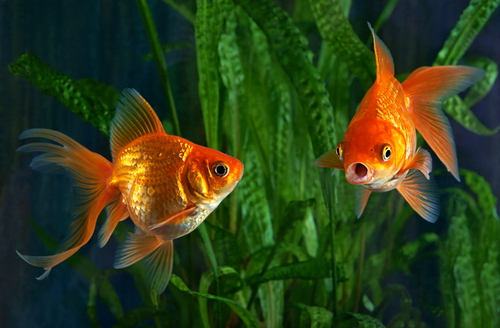Many households keep different fish species as pets, and goldfish are among the most popular types. However, most goldfish owners are unaware of just how much goldfish have in common with other fish species. The question of whether or not goldfish have teeth is of particular interest, and that’s what we will be answering in this article.
So, do goldfish have teeth? The short answer to that question is that goldfish do have teeth. Goldfish teeth aid feeding and digestion and have incredible growth rates.
And as you will soon see, there are a few marked differences between the goldfish’s teeth and that of most other types of animals. At the end of this article, you will know so many cool things about goldfish dentition and understand your little fish pet a little more.
Contents
A Small Refresher on the Goldfish

To understand whether goldfish have teeth, we must know what goldfish are. So, what are they?
Goldfish are a domesticated freshwater fish species related to the brown/dark gray carp found in Asia. In fact, they are a subset of carp. Now, there are numerous goldfish types, the most common type being the golden ones that are so popular.
However, goldfish come in a variety of shapes and sizes. Another popular type is the black moor, which is black in color. Prussian carp are wild goldfish that are silver-green in color. Many of these goldfish types have unique tails.
The goldfish can potentially grow to a maximum length of 23 inches (59 cm) and a maximum weight of 9.9 pounds (4.5 kg). However, this is not the norm; few goldfish ever reach even half this size.
On March 24, 2003, the longest goldfish was measured at 47.4 cm (18.7 in) from snout to tail-fin end in Hapert, The Netherlands. Goldfish can live for more than 20 years if conditions are ideal, but because they spend their lives in bowls, most household goldfish only live for six to eight years.
Fun Fact: A small group of goldfish is known as a glint, but there is also a second name for them—a troubling. You can add that to the list of odd animal group names you know.
Other similar posts you don’t want to miss:
Do Goldfish Have Teeth?
As we’ve mentioned earlier, goldfish do have teeth, though it may not seem apparent initially. Goldfish teeth are not the type of teeth we are used to seeing, and they are not situated in a part of the fish’s mouth that most people expect them to be.
These teeth are also not meant for ripping, tearing, or biting flesh, as many of the other animals that most humans are accustomed to. They are, nevertheless, critical to the goldfish’s physiology and ensure that it lives a long and healthy life.
In any case, you can breathe easy the next time you go swimming in waters that might contain goldfish. Even though goldfish tend to grow to considerable sizes in open waters, you can rest assured that they will not have you for lunch.
So, of course, goldfish teeth are not for eating you; however, this fish’s teeth have evolved for very specific purposes. Like most other animals, there are some foods goldfish cannot swallow hole. This is why goldfish teeth have evolved for grinding food that it the fish can’t swallow.
However, goldfish are not the only animals with teeth used to grind food (human molars, for instance, also serve that purpose).
Where Can You Find the Goldfish Teeth?
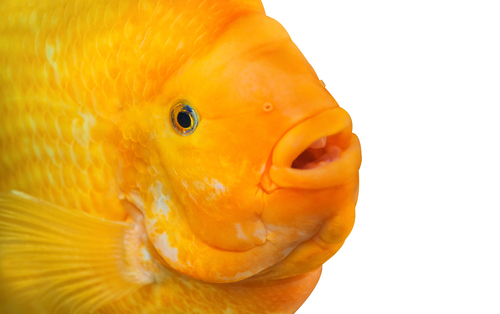
One of the reasons most people don’t realize that goldfish have teeth is that they’re unlike human teeth or that of most other animals. You can be sure you won’t see your goldfish flashing human-like teeth at you anytime soon, and it would be a bad move to go peering into the fish’s mouth in search of teeth. So, where are they found?
Much unlike the human teeth, the teeth don’t grow out of gums in the front of the goldfish’s mouth. Instead, the fish teeth are at the back of the throat. The area is a small section of the goldfish’s anatomy that connects the mouth to the esophagus, and it’s known as the pharynx.
The great majority of living things on the planet have a pharynx, so you and your goldfish have much more in common than you might imagine!
Now, these goldfish teeth are called pharyngeal teeth. They are a common feature among members of the Cyprinidae family of fish, to which the goldfish belong, and as we’ve seen, their special function is to help grind food into smaller particles.
However, many of these other fish with a similar dental structure use their teeth less for grinding than crushing. Some of them also have powerful jaws that give them rather dangerous crushing power.
Do Goldfish Have Sharp Teeth
One obvious feature of this type of tooth is that it is not sharp. Rather, it is similar to the flat teeth of herbivores and the molars of omnivores. Pharyngeal teeth are wide, flat, lack points, and are incapable of tearing flesh or cutting food like typical mouth teeth.
Why Exactly Do Goldfish Need these Teeth?
Goldfish are not predatory fish, so their teeth never evolved beyond this specialized function. And notably, many members of the carp family of fishes share this dental structure with the goldfish. The grinding capability of these teeth is very useful whenever the goldfish eat solid items from their natural surroundings.
Now, most goldfish living in a fishbowl or tank will live on a diet of pellets, flakes, or diced vegetables like lettuce and peas. However, goldfish can also eat insect larvae, zooplankton, and decaying plant and animal materials in their natural environment.
Detritus is dead plant and animal materials that make up a large portion of the wild goldfish’s diet. In any case, because these food particles might be quite sizable, the teeth aid in the grinding process. Because larger foods can pose choking hazards, goldfish teeth have ensured their survival since the species first appeared.
Do Goldfish Bite?

So, now that we’ve established that goldfish have teeth, you naturally want to know if goldfish bite. After all, if they do bite, and they bite like piranhas or pike fish, it may be best to avoid contact with their mouths as much as possible.
The good news is that goldfish biting is quite benign. Goldfish will not sink teeth into your flesh or bite off your finger, as you might fear. The least you can expect from a goldfish is a sucky nibble. Certainly not the stuff of fish-predator films.
Because the goldfish’s teeth are in the rear of its mouth, near the throat, you are unlikely to feel them unless your goldfish is large enough that there is enough space in its mouth for a finger.
Do Goldfish Bites Hurt?
Crushing teeth are typically required to break open hard shells; hence, other fish similar in dental structure will tend to have powerful jaws that might shatter the bones in your fingers. This isn’t true for goldfish, as their jaw power doesn’t pose any threat to your precious bones.
However, goldfish teeth are not necessarily so weak against other fish. Even though goldfish have flat teeth rather than sharp teeth, their teeth can still grip small fish well enough to cause some damage if said fish puts a little fin or tail in their mouth.
There is, however, no cause for massive alarm. Because they are not predatory fish, goldfish are not aggressive. This means you shouldn’t have to worry about them clamping their teeth on other fish in the tank. Goldfish, in fact, are one of the greatest fish to have in a community tank.
If you have an aggressive goldfish though, providing them with enough room and hiding places will typically solve the problem. Fish-keeping measures like this give all the fish enough space to move around and play in without upsetting the other fish in the tank.
Can Goldfish Eat Other Fish?

Goldfish are not likely to eat other fish, though they will eat other sea creatures like shrimp, shrimp, and even fish larvae—even their own! As such, you must be cautious not to keep newborn fish in the aquarium since they may end up as goldfish lunch.
However, to be fair, most fish tend to eat larvae and tiny fish since newly hatched fry are easy prey for everyone in the aquarium.
A goldfish doesn’t have a stomach, so it will tend to frequently consume small amounts of food. If your goldfish is eating other fish, it is most likely because the fish is sick, injured, or unable to swim away.
Can Goldfish Lose Their Teeth?
If you have goldfish in your tank or aquarium, you might notice tiny, strange pellets lying on the gravel every now and then. Most people who keep these fish don’t know what they are.
Well, they are old teeth that have fallen off. It turns out goldfish lose their teeth when said teeth get old. The fish have teeth in reserve just under their gums, waiting to come out when the old teeth fall off.
These new teeth are part of a constant cycle that carries on throughout the fish’s life, with a new tooth replacing every old tooth when the time comes. It would probably be cool if humans could do that, but maybe we wouldn’t find it a very convenient idea to have teeth fall off and regrow all life long.
Do Goldfish Have Dental Problems?
You may have noticed how common it is for human teeth to develop problems, especially when we don’t care for them. Well, as we’ve seen, Goldfish have no need for constant visits to the dentist as they have a strikingly efficient way of renewing their dentition: goldfish lose their teeth when they get old and need replacement.
While this happens only once in humans, it repeatedly happens over a goldfish’s lifetime. However, one can technically say that goldfish do have dental problems, albeit temporary. They do, after all, suffer from tooth decay. However, any decayed teeth are soon replaced, so it’s all good.
Are Teeth Universal Among Fish?
Fish are vertebrates, so teeth are very common among them. In fact, most have one form of teeth or the other in their mouths. Of course, they are too many to list, but let’s look at a few honorable mentions.
1. Sharks
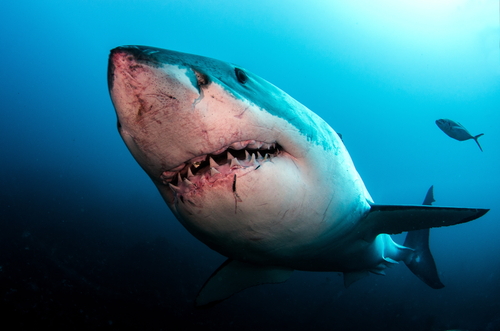
As far as marine predators are concerned, sharks are the most infamous—so much so that they’re the first sea predators anyone ever hears about. Of the many things about sharks, their dangerously sharp teeth are what they are most known for.
In most sharks, this sharpness comes from serrated edges that make them even more ideal for tearing flesh, especially with the sawing motion with which they come together. But shark teeth are generally classified into four types: dense, flattened, needle-like, pointy lower with triangular upper, and non-functional. A shark’s tooth type is determined by its food and eating behavior.
Like goldfish, sharks also shed their teeth. In fact, over the course of its lifetime, the average shark will shed about 35,000 teeth, all of which are replaced.
2. Sheepshead Fish
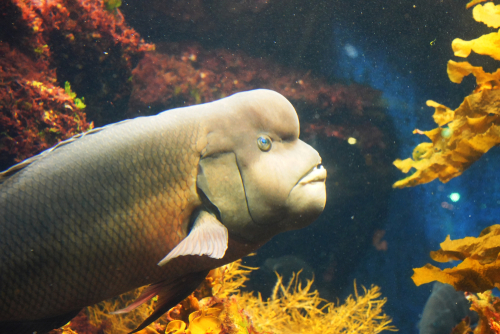
If you have been interested in the subject of fish, you have probably heard of the sheephead fish by now. This fish is famed for its striking human-like teeth, which are very suited for pulling shelled creatures from rocks and crevices and crushing them.
The sheepshead’s front teeth are incisor-like and sharp, similar to human teeth. However, the molar teeth, which are flat, are positioned further back, making them ideal for crushing when combined with the strong jaws of the sheepshead fish.
Because of its human-like teeth, the sheepshead fish is one of the strangest fish to look at, and these teeth tend to appear when they reach maturity.
3. Piranhas

Everyone is familiar with the term “piranha,” especially given this fish’s bloody reputation. They have inspired many gruesome movies and are capable of stripping an animal carcass in minutes. Most people think Piranhas attack upon the sight of flesh, but this isn’t exactly correct. Piranhas are fairly calm actors until they detect blood in the water.
Piranhas have razor-sharp teeth and powerful jaws that can readily rip into flesh, and because they swim in big shoals, a feeding frenzy will soon convert any living creature to neat bone.
Of course, those crazy-sharp teeth get blunted over time from all the flesh-ripping; and so piranhas just lose an entire batch of teeth on one side of their faces and replace all. As has been shown by relatively recent research, they do this simultaneously and multiple times over their lifetimes.
4. Pike Fish
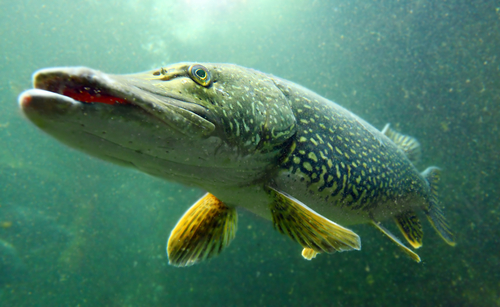
The name ‘pike’ refers to various species of the genus Esox (a Greek word likely borrowed from the Celtic term for certain types of long-bodied freshwater fish). This group of fish is very old, with fossils dating back tens of millions of years. There are four species identified as pike, and their names correspond roughly to where they are found:
- The Northern pike (native to Europe, Northern America, and Northern Asia)
- The Southern pike (found in southern regions like Italy, Switzerland, and Southern France
- The Amur pike (otherwise known as the black-spotted pike, native to the Amur river system in East Asia)
- The Aquitanian pike (found in the South-west region of France)
Pike fish are predatory hunters distinguished by their distinct set of sharp teeth. They have an incredible array of these that can readily pierce through their victim’s flesh.
The majority of their teeth are needle-like, with others larger and more fang-like, lining the upper and lower jaws. Because pike fish teeth are razor-sharp and point inward, their prey cannot escape. Pike fish generally do not bite humans, but they can injure a human’s hand when handled.
5. Tilapia
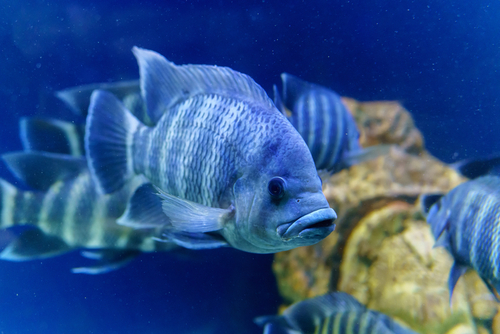
Tilapia refers not to one type of fish but to an entire class of Cichlid fish, and they are known to have spines in their pelvic and anal regions. These fish live in freshwater, though some types are tolerant to brackish water.
Among the other fish we have discussed here, Tilapia stand out because they have two types of teeth. These are the jaw teeth and pharyngeal teeth. Both types of teeth differ in configuration from one tilapia species to the next to accommodate different feeding preferences.
The Jaw teeth are tiny and can have points ranging from one to three. These teeth are organized in 1-5 rows and flattened distally to produce scraper blades. The pharyngeal ones can range in features from fine and thin to robust and coarse.
Summary
Goldfish do have teeth, but they are unique teeth that do not fit the definition of teeth that we are accustomed to. They have pharyngeal teeth, which aid in the crushing and grinding of food for optimal nutritional absorption as it travels through the digestive tract.
Because goldfish lack stomachs, it is critical that they break their food down into small, digestible pieces before it passes through the intestines. Pharyngeal teeth are not harmful to humans, but they do assist your goldfish in maximizing nutrient absorption from their diet.

Ian Sterling, founder of Fishlab.com, began his aquarium journey over 30 years ago, driven by a deep fascination for fish and their diverse personalities. His website, Fishlab.com, is dedicated to making fishkeeping accessible and enjoyable, offering beginner-friendly guidance, expert insights, and a community for aquarists to connect and share experiences.


